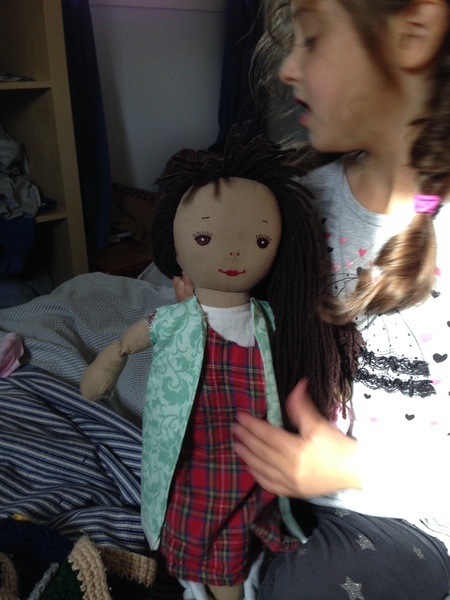I write a post about how well she’s been napping and we have one of those terrible nights.
I suspected it was going to be bad when she first woke an hour and a half after I put her down. She went back to sleep pretty easily after I changed her diaper. I didn’t even nurse her, just rocked her and patted her back.
But then she woke at 1:30 and couldn’t be calmed down. Nursing didn’t work, she was restless and kept hitting me. So I took her to her room and tried rocking and she seemed to doze off and I put her back in the crib and within five or ten minutes she was standing up and rattling the side of the crib. Dom took her and tried to sit with her. She was calm for a while and then started screaming again. When he brought her back to me I tried nursing again and she was just crying too hard, she couldn’t stop long enough to even swallow any milk. She seemed to have a strong preference for having some light on, being in the dark made her more frantic.
We passed her back and forth and finally at about five I was able to rock her gently back to sleep. I took her to bed with me because even in her sleep she was whimpering. We slept on and off until about 8:30 when she woke in a good mood. She didn’t go down for a nap after breakfast, not too surprised about that. I hope she’ll take a good long one later, though.







Thank you! Thank you! I have been looking for some kind of analysis of these last few pages of this book for years. I have never gotten it and no one else has even attempted to give an analysis anywhere on-line that I can find. Now I can go back and read the book again with this analysis in mind.
Ian,
You’re welcome. I was troubled too and searching for some rational commentary. I guess sometimes when you can’t find what you want you end up doing it yourself.
Though I’m convinced that had I not picked up Till We Have Faces, I’d still be wandering in the dark. I guess it’s lucky that my sister convinced me I needed to re-read that book.
I’m glad to be able to help and I look forward to any further input you may have when you get around to that re-reading. I still feel like there are a few pieces that haven’t clicked. I’m still a bit puzzled about the wandering Jew, for example.
Father Barry,
I’m glad you think it works. I think your ideas did help push me along.
I think that all the clues add up to the spaceship with Brother Joshua and his followers representing more than just a colonization effort. We are meant to think about the idea of a new earth with the Biblical echoes. It’s a metaphor for final judgment, but the judgment specifically of the blessed, those who get a “straight shot” into heaven, I think. It seemed to me almost analogous to the Rapture, being swept directly to heaven. Especially if you consider Joshua as a symbolic name, in the Old Testament Joshua leads the people to the promised land, which is a type of Jesus leading the people of God into heaven. I think that name cannot be a coincidence.
Thanks for the Latin link. That is helpful for one whose Latin is getting a bit rusty and who doesn’t necessarily recognize all the source texts.
Wow, Melanie.
I’m in awe. So much great material here.
Especially fond of the idea that Mrs. Grales’ deformity is a metaphor for original sin. And also of that “apocalyptic, not post-apocalyptic” notion. So many things fall into place when you start looking at the finale that way.
The New Eve/resurrected body explanation is spot-on, I think. It’s what I was trying to get at in discussing the final scene as the point where the earth was reborn, though I did not have those details in my mind anywhere near as clearly as you lay out here. (And I was not yet at the point where I was focusing on Rachel in this new context.)
And it does a wonderful job of explaining the part of that final scene that always troubled me the most: Rachel’s rejection of baptism. That points strongly to “the New Eve” side of things, I think. Either she is inexplicably rejecting the means of her salvation, or…she does not need to be saved. (I wonder if there is meant to be any connection between her and St. Agnes…)
So, do you think Brother Joshua and his followers are going to another planet? Or are they going to the Final Judgement? I read an article that was struck by the fact that Miller uses sic transit mundus instead of sic transit gloria mundi. Not exactly sure what to make of all that, though Wikipedia’s PAGE on the Latin used in the book is fascination stuff.
Thanks for putting all of this together! (Now, to turn my attention to Till We Have Faces…)
The Rapture was one of the first things I thought about when reading that section of your analysis, actually. But I also think it’s a point most people could easily miss. More than any other place, I think the “apocalyptic, not post-apocalyptic” idea impacts the story profoundly here.
(Oh, and I wish I could get myself back to the place where my Latin was only “a bit rusty.” That would be great.)
Hi Melanie, I thought I would let you know about the summer reading program at [url=http://www.catholicsummerreading.com]http://www.catholicsummerreading.com[/url] It looks like Canticle will probably be one of the books discussed.